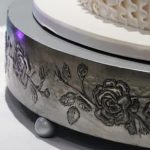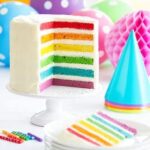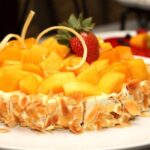Creative cake decorations have become a trend in the world of baking, and the combination of fondant and buttercream is highly sought after. But can you really put fondant decorations on a buttercream cake? In this blog post, we will delve into the intricacies and possibilities of this delicious duo, debunking myths and providing valuable tips along the way.
Before diving into the main question, it’s important to understand the fundamental differences between fondant and buttercream. We will explore their unique characteristics, textures, and purposes in cake decorating, setting the stage for further analysis.
The burning question addressed. We will discuss whether it is feasible to place fondant decorations on a buttercream cake without compromising taste or texture. Delve into the science behind it as we unravel the secrets of successful composition.
Understanding the Basics
Before delving into the intricacies of placing fondant decorations on a buttercream cake, it’s crucial to understand the fundamental differences between fondant and buttercream. Each medium has its unique characteristics, textures, and purposes in cake decorating.
Fondant:
Fondant is a pliable sugar-based dough that can be rolled out and draped over cakes for a smooth and flawless finish. It is known for its versatility and ability to create intricate designs, making it popular for wedding cakes and special occasion treats.
Buttercream:
Buttercream, on the other hand, is a creamy frosting made from butter, confectioners’ sugar, and flavorings. It has a light and fluffy texture with a rich taste due to the high-fat content of butter. Buttercream is commonly used for piping borders, rosettes, flowers, and other decorative elements.
Now that we have defined the basics of these two mediums let’s move on to assessing their compatibility when combined.
- Fondant offers a smooth canvas that provides an ideal surface for detailed decorations. Its pliability allows for intricate sculpting and shaping that may not be achievable with buttercream alone.
- Buttercream adds flavor, richness, and moisture to cakes while providing a creamy base for fondant decorations to adhere to.
- One important consideration when combining fondant with buttercream is the stability of the cake. Fondant tends to provide more support due to its firmness when set whereas buttercream can sometimes be softer or melt in warmer conditions.
Having understood the unique qualities of each medium, we can now explore the feasibility of placing fondant decorations on a buttercream cake without compromising taste or texture.
Assessing Compatibility
When it comes to the compatibility of fondant decorations on a buttercream cake, the answer is a resounding yes. While some may believe that these two mediums don’t mix well together, with proper techniques and preparation, you can achieve a stunning cake creation that combines the best of both worlds. Let’s take a closer look at why this combination is not only possible but also results in a delightful treat.
Fondant and buttercream have distinct characteristics that make them suitable for different decorating purposes. Buttercream is creamy, smooth, and perfect for creating fluffy textures and achieving a silky finish. On the other hand, fondant provides a sleek and polished look, making it ideal for detailed designs and intricate patterns. By combining these two techniques, you can create cakes that are not only visually appealing but also offer a pleasing contrast in taste and texture.
To ensure successful compatibility between fondant decorations and a buttercream cake, it’s important to prepare your cake canvas properly. One essential step is chilling your cake before applying fondant. This helps the buttercream to firm up, offering stability when adding the weight of fondant decorations.
Additionally, crumb coating your cake with buttercream creates a smooth surface that prevents crumbs from showing through the fondant layer. Achieving a flawless finish will give your fondant decorations an even surface to adhere to.
Once your buttercream canvas is prepared, it’s time to choose the perfect fondant decorations that will complement your creation. Some types of designs work particularly well with buttercream cakes, such as 3D figurines or delicate floral accents.
These can be placed directly on top of the buttercream without compromising their shape or structure. Consider using silicone molds or cutters to create precise shapes with fondant or even mix elements such as handmade sugar flowers with fondant details for added dimension.
By understanding the compatibility of fondant decorations on a buttercream cake and following the proper techniques, you can achieve a delightful combination of flavors, textures, and aesthetics. The possibilities are truly endless when it comes to creating stunning cakes that will impress both visually and gustatorily.
- Ensure your buttercream is well-chilled before applying fondant.
- Apply a crumb coating to create a smooth surface.
- Select fondant decorations that work well with buttercream, such as 3D figurines or delicate floral accents.
- Use silicone molds or cutters for precise shapes with fondant.
Preparing Your Buttercream Canvas
Cake Chilling
One of the essential steps in preparing your buttercream canvas is to chill the cake. Chilling the cake not only helps to set the buttercream and prevent it from melting when fondant decorations are applied, but it also improves the stability of the cake.
Before chilling, make sure that you have crumb coated your cake with a thin layer of buttercream to seal in any loose crumbs. Then, place the cake in the refrigerator for at least 30 minutes, or until the buttercream is firm to the touch.
Crumb Coating
To achieve a smooth and flawless surface for your fondant decorations, applying a crumb coat is crucial. This involves spreading a thin layer of buttercream all over the chilled cake to trap any loose crumbs and create an even base. Start by applying a thin layer of buttercream with an offset spatula or bench scraper, ensuring that you cover all sides of the cake.
Smooth out any rough edges or imperfections as you go. Once done, refrigerate the cake again until the crumb coat is set.
Achieving a Smooth Finish
To give your fondant decorations a professional finish and improve their adherence to the buttercream surface, it’s important to achieve a smooth finish on your cake. After applying the crumb coat and allowing it to chill, use a clean bench scraper or an icing smoother to gently scrape off any excess buttercream and create an even surface.
Continue scraping until all sides of the cake are smooth and free from visible ridges or bumps. The smoother and flatter your surface is, the better your fondant decorations will adhere.
By following these preparation techniques, you will provide yourself with a solid foundation for placing fondant decorations on your buttercream cake. Not only will this ensure compatibility between these two mediums but also result in visually stunning cakes that are sure to impress.
The Perfect Fondant Decorations for Buttercream
In order to create a cohesive and visually appealing cake, it is important to choose the right fondant decorations that work harmoniously with buttercream. Not all fondant designs are ideal for a buttercream canvas. Some may be too heavy or may not adhere well to the buttercream surface, causing potential issues. In this section, we will explore different types of fondant decorations that are perfect for buttercream cakes.
One option for fondant decorations on a buttercream cake is delicate floral accents. These can include small flowers, petals, or leaves made out of fondant. These decorations add an elegant and romantic touch to the cake and can be arranged strategically on the buttercream surface.
Another popular choice for fondant decorations on buttercream cakes is intricate fondant figurines. These can include characters, animals, or other objects sculpted from fondant. These figurines can serve as the centerpiece of the cake and add a fun and whimsical element to the overall design.
Furthermore, simple fondant cutouts or molds can also be used to create beautiful and unique decorations on a buttercream cake. These can include shapes like hearts, stars, or other custom designs that complement the theme or occasion of the cake.
By choosing these types of fondant decorations that are light in weight and adhere well to the buttercream surface, you can ensure a successful integration between the two mediums. The combination of delicate floral accents, intricate figurines, and simple cutouts will elevate your buttercream creation and impress both visually and in taste.
| Type | Benefits | Examples |
|---|---|---|
| Delicate Floral Accents | Elegant and romantic touch | Small flowers, petals, leaves |
| Intricate Fondant Figurines | Fun and whimsical element | Characters, animals, objects |
| Simple Fondant Cutouts or Molds | Custom designs to complement the theme | Hearts, stars, custom shapes |
Proper Application Techniques
Applying fondant decorations on a buttercream cake requires finesse and precision. To ensure a seamless integration, here are the step-by-step techniques you need to follow:
- Preparing the Fondant: Before applying fondant to your buttercream cake, make sure it is at room temperature and pliable. Knead the fondant until it is smooth and no longer sticky. If needed, you can dust your workspace with powdered sugar or cornstarch to prevent sticking.
- Rolling Out the Fondant: Using a rolling pin, roll out the fondant into a thin, even layer that is slightly larger than the size of your cake. Be careful not to roll it too thin as it may tear or break when placing it on the cake.
- Covering the Cake: Gently lift the rolled out fondant and drape it over the cake. Start from the center and carefully work your way outwards, smoothing any air bubbles or wrinkles as you go. Use your hands or a fondant smoother for this process. Trim off any excess fondant using a sharp knife.
- Adhering the Fondant: To ensure that the fondant sticks well to the buttercream surface, brush a thin layer of water or clear alcohol (such as vodka) onto the buttercream before placing the fondant on top. This helps create a bond between the two mediums.
- Smoothing and Shaping: Once you have applied the fondant onto your cake, use gentle pressure with your hands or a smoother to smooth out any imperfections or seams in the fondant. Start from the top of the cake and work your way downwards.
- Adding Details: If you want to add additional details such as cutouts, embossing, or texture to your fondant decorations, now is the time to do so. For intricate designs, use small amounts of water or edible glue to attach the details onto the fondant.
By following these proper application techniques, you can ensure that your fondant decorations adhere smoothly to your buttercream cake, creating a visually stunning and delicious masterpiece. Remember to practice patience and take your time during the application process for the best results.
| Proper Application Techniques |
|---|
| Preparing the Fondant |
| Rolling Out the Fondant |
| Covering the Cake |
| Adhering the Fondant |
| Smoothing and Shaping |
| Adding Details |
Addressing Potential Challenges and Troubleshooting
Decorating a buttercream cake with fondant decorations presents its fair share of challenges. However, armed with the right knowledge and techniques, you can overcome these obstacles and create a stunning masterpiece. In this section, we will address common challenges that may arise when combining fondant and buttercream, and provide effective troubleshooting advice to help you navigate through any unforeseen issues.
Preventing Fondant from Melting
One of the biggest concerns when working with fondant on a buttercream cake is the potential melting of the fondant. As buttercream is made primarily from fats, it can cause the fondant to soften and lose its shape, resulting in a saggy or sticky appearance. To prevent this from happening, it is crucial to keep your cake chilled before applying the fondant.
Before covering your cake with fondant, refrigerate it for at least 30 minutes to ensure that the buttercream has firmed up. Avoid leaving your cake out in warm temperatures for extended periods as this can also contribute to melting issues. Additionally, work in a cool environment and handle the fondant decorations with light hands to minimize warmth transfer.
Fixing Imperfections
Despite your best efforts, imperfections on your buttercream cake may still arise while applying fondant decorations. The good news is that most flaws can be easily fixed or concealed with a few simple tricks.
If there are air bubbles trapped between the fondant and buttercream surface, gently puncture them using a toothpick or pin. Smooth out any wrinkles or creases by carefully lifting and repositioning the fondant while supporting it from underneath. If you notice any cracks or tears in the fondant after application, use a small amount of water or edible glue to mend them seamlessly.
Remember that practice makes perfect. If you encounter challenges along the way, don’t be discouraged. Treat each cake as a learning opportunity and keep experimenting with different techniques until you achieve the desired result.
Handling Humidity and Storage
Humidity can be a cake decorator’s worst enemy, especially when working with fondant on a buttercream cake. High moisture levels in the air can cause fondant to become sticky or start sweating, leading to a compromised appearance.
To combat humidity, make sure to store your finished buttercream cake in a cool, dry place away from direct sunlight. If you live in an especially humid climate, consider using a dehumidifier or air conditioning to regulate the environment while you work on your masterpiece.
Another helpful tip is to apply a thin layer of shortening on your work surface before rolling out the fondant. This will create a barrier between the fondant and any residual moisture on the surface, making it easier to handle.
By addressing these potential challenges and armed with troubleshooting advice, you can confidently tackle any issues that may arise when combining fondant decorations with a buttercream cake. With patience and practice, you will soon master the art of creating beautiful and delicious cakes that will wow both the eyes and taste buds.
Expert Inspiration
In the world of cake decorating, inspiration can be found in every corner. When it comes to combining fondant decorations with buttercream cakes, expert bakers have truly mastered the artistry, creating stunning creations that captivate both the eyes and the taste buds. Let’s explore some examples of breathtaking buttercream cakes adorned with fondant decorations that will spark your own creative ideas.
First, we have whimsical birthday cakes that are perfect for adding a touch of magic to any celebration. Imagine a buttercream cake topped with fondant unicorns, rainbows, and sparkling stars. These enchanting creations make for unforgettable birthday moments and are beloved by children and adults alike.
For elegant occasions such as weddings or anniversaries, fondant decorations can elevate a simple buttercream cake into a work of art. Delicate sugar flowers cascading down the tiers, exquisite lace patterns meticulously crafted in fondant, or even sophisticated monogram designs bring elegance and sophistication to these special events.
Another trend gaining popularity is the use of fondant figurines on top of buttercream cakes. Skilled bakers create realistic representations of people or objects using this versatile medium. From adorable baby shower cakes featuring fondant babies to detailed superhero-themed creations complete with edible cape-wearing figures, these cakes showcase the limitless potential when combining fondant decorations with smooth buttercream surfaces.
Finally, let’s not forget about seasonal celebrations that call for themed cake designs. Whether it’s Halloween pumpkins made from vibrant orange fondant sitting atop rich buttercream or delicate pastel-colored Easter eggs perfectly placed on a fluffy white cake, these creations add an extra layer of joy and festivity to any holiday gathering.
By exploring these expert examples of stunning buttercream cakes adorned with fondant decorations, you gain invaluable inspiration for your own cake decorating endeavors. Remember to let your imagination be your guide and have confidence in your skills. With practice and creativity, you can achieve breathtaking designs that will leave a lasting impression on anyone fortunate enough to enjoy your delicious creations.
Conclusion
In conclusion, the combination of fondant decorations on a buttercream cake is not only possible but can also result in stunning and delicious creations. By understanding the differences between fondant and buttercream, adequately preparing the buttercream surface, and applying the fondant decorations with finesse, you can achieve a seamless integration that both pleases the eye and delights the taste buds.
Throughout this blog post, we have explored various techniques and tips to ensure a successful union of fondant and buttercream. From chilling the cake to crumb coating and achieving a smooth finish, these preparatory steps are crucial in providing a flawless canvas for fondant decorations. Additionally, we have discussed different types of fondant designs that work harmoniously with buttercream cakes, allowing you to unleash your creativity while keeping compatibility in mind.
While challenges may arise when working with fondant and buttercream, it is important to remember that troubleshooting advice is available to overcome any hurdles. Whether it’s preventing melting or fixing imperfections, arming yourself with knowledge will empower you to find solutions and create beautiful cakes.
Frequently Asked Questions
Will fondant decorations stick to buttercream?
Fondant decorations can stick to buttercream if applied correctly. However, it is important to ensure that the buttercream is not too soft or too moist, as this can cause the fondant to slide or melt off the cake. To adhere fondant decorations to buttercream, a thin layer of buttercream can be spread on the area where the fondant will be placed.
This acts as a glue-like substance, allowing the fondant to adhere securely. Additionally, pressing gently on the fondant decoration can help it stick more firmly to the buttercream surface.
Will fondant go soft on buttercream?
Fondant can become soft when placed on top of buttercream due to the moisture from the frosting. Buttercream contains fats and liquids that can affect the texture of fondant, causing it to soften over time. The length of time it takes for this softening process to occur depends on various factors such as humidity and temperature.
It is recommended not to refrigerate cakes with fondant decorations since condensation can make the fondant sticky or even melt. To prevent excessive softening, it is advisable to place fondant decorations on buttercream shortly before serving or display them in a cool environment.
Will colored fondant bleed onto buttercream?
Colored fondant has a possibility of bleeding onto buttercream if certain precautions are not taken. Since fondant is made with water and food coloring, excess moisture from colored fondant can transfer onto adjacent surfaces like buttercream and cause them to become discolored or stained. To minimize color bleeding, it is recommended that you allow colored fondant decorations to dry at room temperature before applying them onto a cake covered in buttercream.
Additionally, avoid touching wet or freshly colored parts of fondant while working with it and handle it carefully when placing it on top of buttercream icing. By taking these precautions, you can reduce the chances of colored fondants bleeding onto your buttercream surface.

Welcome to my blog about home and family. This blog is a place where I will share my thoughts, ideas, and experiences related to these important topics. I am a stay-at-home mom with two young children. I hope you enjoy reading it! and may find some helpful tips and ideas that will make your home and family life even better!





